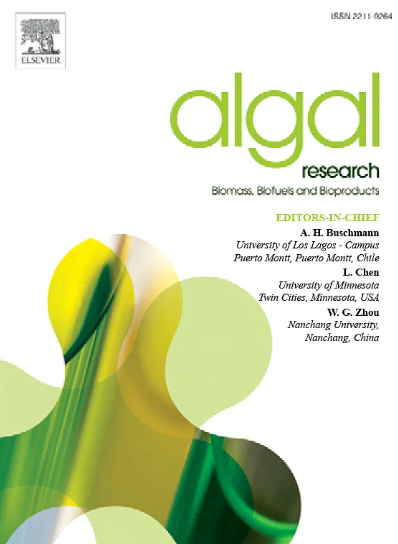Brown alga Costaria costata as a source of phlorethol that inhibits TPA-induced neoplastic cell transformation and progression of human breast cancer cells via AKT/GSK-3β/CDKs pathway
IF 4.6
2区 生物学
Q1 BIOTECHNOLOGY & APPLIED MICROBIOLOGY
Algal Research-Biomass Biofuels and Bioproducts
Pub Date : 2025-06-20
DOI:10.1016/j.algal.2025.104162
引用次数: 0
Abstract
Phlorotannins are polyphenolic compounds synthesized by brown algae that have recently attracted great interest due to their unique structure, vast range of bioactivities, and potential applications in human health and nutrition. In the present study, the chemical structure of phlorethol from the brown alga Costaria costata (CcPh) is elucidated. Its effect and molecular mechanisms of anticancer action are assessed using the models of 12-O-tetradecanoylphorbol-13-acetate (TPA)-induced tumorigenic transformation of mouse epidermal JB6 Cl41-5a cells and human triple-negative breast cancer MDA-MB-231 cells. It has been found that CcPh having a degree of polymerization of 12–25 phloroglucinol units and a molecular weight of 2520 Da, belong to the phlorethol class. CcPh shows cytotoxic activity against non-induced and TPA-induced JB6 Cl41-5a cells with IC50 = 97.1 ± 3.0 and 114.3 ± 2.2 μg/mL, respectively, or MDA-MB-231 cells with IC50 = 95 ± 1.2 and 109 ± 7.5 μg/mL, respectively. CcPh effectively inhibits TPA-induced neoplastic transformation of JB6 Cl41-5a cells, colony formation, and migration of MDA-MB-231 cells through the inhibition of AKT and GSK-3β kinase phosphorylation and the regulation of cell cycle protein (CDK4, Cyclin D1, and p21) expression. These properties of phlorotannins provide a wide range of opportunities for the development of new approaches to prevention and therapy of highly aggressive forms of breast cancer in the future.
棕藻Costaria costata可通过AKT/GSK-3β/CDKs途径抑制tpa诱导的肿瘤细胞转化和人乳腺癌细胞的进展
褐藻单宁是一种由褐藻合成的多酚类化合物,由于其独特的结构、广泛的生物活性以及在人类健康和营养方面的潜在应用,近年来引起了人们的广泛关注。本文研究了棕藻Costaria costata (CcPh)中邻苯酚的化学结构。采用TPA诱导小鼠表皮JB6 Cl41-5a细胞和人三阴性乳腺癌MDA-MB-231细胞的致瘤转化模型,评价其抗癌作用及其分子机制。发现CcPh聚合度为12-25个间苯三酚单位,分子量为2520da,属于间苯酚类。CcPh对非诱导和tpa诱导的JB6 Cl41-5a细胞(IC50分别为97.1±3.0和114.3±2.2 μg/mL)和MDA-MB-231细胞(IC50分别为95±1.2和109±7.5 μg/mL)具有细胞毒活性。CcPh通过抑制AKT和GSK-3β激酶磷酸化,调控细胞周期蛋白(CDK4、Cyclin D1和p21)表达,有效抑制tpa诱导的JB6 Cl41-5a细胞的肿瘤转化、MDA-MB-231细胞的集落形成和迁移。紫单宁的这些特性为未来开发新的方法来预防和治疗高侵袭性乳腺癌提供了广泛的机会。
本文章由计算机程序翻译,如有差异,请以英文原文为准。
求助全文
约1分钟内获得全文
求助全文
来源期刊

Algal Research-Biomass Biofuels and Bioproducts
BIOTECHNOLOGY & APPLIED MICROBIOLOGY-
CiteScore
9.40
自引率
7.80%
发文量
332
期刊介绍:
Algal Research is an international phycology journal covering all areas of emerging technologies in algae biology, biomass production, cultivation, harvesting, extraction, bioproducts, biorefinery, engineering, and econometrics. Algae is defined to include cyanobacteria, microalgae, and protists and symbionts of interest in biotechnology. The journal publishes original research and reviews for the following scope: algal biology, including but not exclusive to: phylogeny, biodiversity, molecular traits, metabolic regulation, and genetic engineering, algal cultivation, e.g. phototrophic systems, heterotrophic systems, and mixotrophic systems, algal harvesting and extraction systems, biotechnology to convert algal biomass and components into biofuels and bioproducts, e.g., nutraceuticals, pharmaceuticals, animal feed, plastics, etc. algal products and their economic assessment
 求助内容:
求助内容: 应助结果提醒方式:
应助结果提醒方式:


